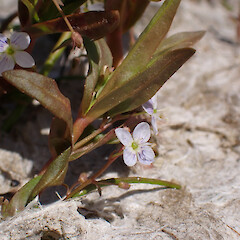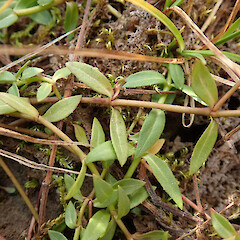Veronica scutellata
Common name
marsh speedwell
Family
Plantaginaceae
Flora category
Vascular – Exotic
Structural class
Herbs - Dicotyledons other than Composites
NVS code
The National Vegetation Survey (NVS) Databank is a physical archive and electronic databank containing records of over 94,000 vegetation survey plots - including data from over 19,000 permanent plots. NVS maintains a standard set of species code abbreviations that correspond to standard scientific plant names from the Ngä Tipu o Aotearoa - New Zealand Plants database.
VERSCU
Conservation status
Not applicable
Brief description
Sprawling perennial herb up to 30 cm tall with opposite narrow stalkless leaves and small (c.1 cm across) white flowers.
Distribution
Found locally in Thames, Waikato, Manawatu, Wairarapa, Canterbury, Dunedin and the West Coast.
Habitat
Shallow water, swamps and margins of waterways.
Wetland plant indicator status rating
Information derived from the revised national wetland plant list prepared to assist councils in delineating and monitoring wetlands (Clarkson et al., 2021 Manaaki Whenua – Landcare Research Contract Report LC3975 for Hawke’s Bay Regional Council). The national plant list categorises plants by the extent to which they are found in wetlands and not ‘drylands’. The indicator status ratings are OBL (obligate wetland), FACW (facultative wetland), FAC (facultative), FACU (facultative upland), and UPL (obligate upland). If you have suggestions for the Wetland Indicator Status Rating, please contact: [Enable JavaScript to view protected content]
OBL: Obligate Wetland
Almost always is a hydrophyte, rarely in uplands (non-wetlands).
Detailed description
Glabrous herb with upright stems c.5 to 20 cm in length. The leaves are sessile, entire or sparsely toothed 2-6 cm x 0.1-1.2 cm. The flowers are in racemes that are slender and spreading, alternating in opposite pairs of leaves. Flowers are small (6mm across), and whitish in colour with purple veins. Capsule 3-4.5 mm wide.
Similar taxa
Distinguished by its alternate flower stalks, linear leaves and white flowers with purple veins.
Flowering
Summer to autumn
Flower colours
Violet/Purple, White
Fruiting
Autumn
Year naturalised
1924
Origin
Temperate Eurasia
Reason for introduction
Probably a soil seed contaminant or contaminant of ornamental pond plants.
Control techniques
Not controlled in New Zealand.
Etymology
veronica: Named after Saint Veronica, who gave Jesus her veil to wipe his brow as he carried the cross through Jerusalem, perhaps because the common name of this plant is ‘speedwell’. The name Veronica is often believed to derive from the Latin vera ‘truth’ and iconica ‘image’, but it is actually derived from the Macedonian name Berenice which means ‘bearer of victory’.
Attribution
Factsheet prepared by Paul Champion and Deborah Hofstra (NIWA).
References and further reading
Johnson P.N., and Brooke P.A. 1989: Wetland plants in New Zealand. DSIR Field Guide, DSIR Publishing, Wellington. 319 pp.
Popay I. et al. 2010: An illustrated guide to common weeds of New Zealand, third edition. NZ Plant Protection Society Inc. 416 pp.







